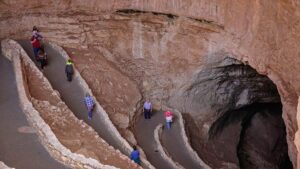Switchbacks are a common feature found on hiking trails, serving a specific purpose in trail design. By using a series of sharp turns and gradual ascents or descents, switchbacks allow hikers to navigate steep slopes with greater ease and safety. This technique is employed to manage elevation gain while minimizing the overall gradient of the trail.
Understanding how to identify and effectively hike switchbacks is essential for outdoor enthusiasts seeking to traverse challenging terrains efficiently. Despite their advantages, switchbacks also present unique challenges that must be considered during hiking expeditions.
Key Takeaways What Are Switchbacks in Hiking
- Switchbacks are trail designs that involve a series of sharp turns or bends.
- They make it easier for hikers to ascend or descend steep slopes more gradually and efficiently.
- Switchbacks help prevent erosion and minimize soil disturbance and vegetation damage.
- They offer a safer and more manageable route, reducing the overall gradient and providing a more enjoyable hiking experience.
Definition of Switchbacks
A switchback, in the context of hiking trails, refers to a trail design that involves a series of sharp turns or bends in order to ascend or descend steep slopes more gradually and efficiently. The purpose of switchbacks is to mitigate the impact of steep terrain on hikers by providing a safer and more manageable route.

By creating a zigzag pattern up or down the slope, switchbacks reduce the incline of the trail, making it easier for hikers to navigate. This design also helps prevent erosion by allowing water to flow off the trail instead of running straight downhill. Additionally, switchbacks minimize soil disturbance and vegetation damage caused by hikers trying to climb or descend slopes directly.
Overall, switchbacks offer numerous benefits such as improved safety, reduced environmental impact, and enhanced hiking experience.
Purpose of Switchbacks in Hiking
The purpose of utilizing a series of zigzagging paths on steep trails is to reduce the overall gradient and provide a more manageable ascent or descent for hikers. Switchbacks are crucial in mountainous terrain as they allow hikers to navigate challenging slopes while minimizing the strain on their bodies.

By creating a gradual incline, switchbacks make it easier for hikers to maintain their balance and conserve energy during steep climbs or descents. Additionally, these paths prevent erosion and limit environmental damage caused by foot traffic.
Switchbacks help distribute the impact of hiking activities across a wider area, reducing soil compaction and preserving vegetation along the trail. This strategy is particularly important in fragile ecosystems where maintaining biodiversity and minimizing human disturbances are essential goals for sustainable hiking practices.
Advantages of Switchbacks on Trails
Switchbacks on hiking trails offer several advantages.
Firstly, they make the uphill ascent easier for hikers by breaking down the steep incline into a series of smaller, more manageable sections. This reduces fatigue and allows hikers to conserve their energy for longer hikes.

Additionally, switchbacks help prevent erosion damage to the trail by diverting water flow and reducing the risk of soil erosion. This helps maintain the integrity and sustainability of the trail system.
Lastly, switchbacks improve trail navigation by providing clear paths that guide hikers through challenging terrain. They serve as visual markers that help hikers stay on track and navigate through complex landscapes with ease.
Easier Uphill Ascent
Utilizing switchbacks in hiking trails facilitates a more gradual and manageable uphill ascent. Switchback techniques involve creating a series of zigzagging paths that allow hikers to traverse steep inclines with less effort.

By incorporating switchbacks, the trail designer can reduce the overall grade of the trail, making it easier for hikers to ascend without excessive strain on their muscles and joints. The use of switchbacks also helps to prevent erosion by reducing the flow of water down the slope. Additionally, switchbacks offer hikers an opportunity to enjoy panoramic views as they ascend gradually, rather than tackling a steep climb all at once. Overall, implementing switchbacks is an effective way to enhance the hiking experience and ensure a safer and more enjoyable journey for outdoor enthusiasts.
| Pros | Cons |
|---|---|
| Easier uphill ascent | Longer trail distance |
| Reduced muscle strain | Increased construction efforts |
| Prevents erosion | Requires proper maintenance |
| Offers scenic viewpoints | May disrupt natural habitats |
Prevent Erosion Damage
Implementing techniques to prevent erosion damage is crucial in maintaining the integrity and sustainability of hiking trails. Erosion can cause significant damage to the natural environment, leading to soil loss, trail degradation, and increased sedimentation in nearby water sources. To combat erosion on hiking trails, various erosion prevention techniques are employed, including switchback construction methods.
Here are four key techniques used in switchback construction:
- Grade reversals: By changing the slope direction periodically along a trail, grade reversals help slow down water flow and reduce erosion potential.
- Water bars: These structures divert water off the trail by creating small channels perpendicular to the path, preventing excessive water accumulation that can lead to erosion.
- Retaining walls: Constructed using rocks or timber, retaining walls provide structural support to prevent soil movement on steep slopes.
- Vegetation cover: Planting native vegetation along hiking trails helps stabilize the soil, reducing erosion caused by wind and water.
Improved Trail Navigation
To enhance trail navigation, the incorporation of clear signage and markers is essential in ensuring that hikers can easily follow designated paths. Clear and visible signs provide crucial information about the trail, including directions, distances, and potential hazards. Additionally, markers such as blazes or cairns help hikers stay on track by indicating the correct path at intersections or when the trail becomes less distinct. By improving trail navigation through effective signage and markers, several benefits can be achieved. Firstly, it enhances trail safety by reducing the chances of hikers getting lost or taking wrong turns. Secondly, it helps to reduce trail maintenance efforts as hikers are less likely to wander off-trail where they could cause damage to vegetation or erode soil.
| Benefits | Improved Trail Navigation |
|---|---|
| Trail Safety | Reduces chances of getting lost or taking wrong turns |
| Trail Maintenance | Decreases damage to vegetation and soil erosion |
Table: Benefits of Improved Trail Navigation
How to Identify Switchbacks on a Hiking Trail
One way to identify switchbacks on a hiking trail is by looking for the zigzag pattern of the trail as it ascends or descends a steep slope. Switchbacks are designed to make traversing difficult terrain more manageable by incorporating a series of sharp turns.
Here are some key features that can help in identifying switchbacks:
- Zigzag pattern: The trail will have a distinct back-and-forth pattern, resembling the shape of the letter ‘Z.’
- Steepness: Switchbacks are often found on trails with steep slopes, where direct ascent or descent would be impractical.
- Elevation gain: As you hike along the switchback, you’ll notice a gradual increase in elevation as you move up or down the slope.
- Distance: Switchbacks tend to cover more ground than straight sections of trail, as they add extra distance while easing the gradient.
Tips for Hiking Switchbacks Effectively
A systematic approach can enhance the efficiency and safety of navigating switchbacks on a trail. When hiking switchbacks, it is important to consider various factors such as proper footwear, hydration, and nutrition. Wearing the right footwear is crucial to ensure stability and prevent injuries. Hikers should opt for sturdy hiking boots with good traction to navigate steep or uneven terrain effectively. Additionally, maintaining proper hydration levels is essential during strenuous activities like hiking switchbacks. Carrying an adequate amount of water and electrolyte-rich drinks helps prevent dehydration and fatigue. Likewise, proper nutrition plays a vital role in providing sustained energy throughout the hike. Consuming high-energy snacks like granola bars or nuts can help replenish nutrients and maintain stamina during long hikes. By considering these factors, hikers can optimize their performance while ensuring their safety on switchback trails.
| Factors | Importance |
|---|---|
| Proper Footwear | Crucial |
| Hydration | Essential |
| Nutrition | Vital |
Common Challenges of Hiking Switchbacks
Common challenges encountered when navigating switchbacks on a trail include steep inclines, uneven terrain, and potential fatigue. These challenges can make hiking switchbacks physically demanding and mentally challenging.
Here are some common challenges of hiking switchbacks:
- Steep inclines: Switchbacks are designed to mitigate the steepness of a trail by zigzagging up the slope. However, they still involve climbing uphill, which requires increased effort and stamina.
- Uneven terrain: Switchbacks often traverse rocky or uneven terrain, making it necessary for hikers to carefully navigate their steps to avoid potential tripping hazards.
- Potential fatigue: Switchbacks can be long and relentless, testing hikers’ endurance levels as they ascend multiple turns and changes in elevation.
- Mental perseverance: The repetitive nature of switchbacks may lead to monotony or frustration for some hikers, requiring mental strength to stay motivated.
Understanding these common challenges is crucial for preparing oneself adequately before embarking on a hike with switchbacks.
Now let’s explore some famous hiking trails that feature challenging switchback sections.
Famous Hiking Trails With Switchbacks
Famous hiking trails renowned for their challenging sections featuring switchbacks demonstrate the physical demands and mental fortitude required to navigate these zigzagging paths. Switchbacks, or hairpin turns in a trail, are a common feature found in many popular hiking routes around the world. These trails not only provide breathtaking views but also offer hikers numerous benefits. Switchbacks reduce the steepness of climbs, making them more manageable and less physically taxing. They also prevent soil erosion by evenly distributing foot traffic and water runoff along the trail. Additionally, switchbacks allow hikers to ascend or descend mountains safely by minimizing the risk of falls or accidents. Some notable famous switchback trails include Angel’s Landing in Zion National Park (USA), Inca Trail to Machu Picchu (Peru), and Mount Huashan Plank Walk (China).
| Famous Switchback Trails |
|---|
| Angel’s Landing |
| Inca Trail |
| Mount Huashan |
Frequently Asked Questions
Are Switchbacks Only Found on Steep Hiking Trails?
Switchbacks can be found on both steep and flat hiking trails. On flat terrain, switchbacks offer several benefits such as reducing erosion, providing a gradual ascent or descent, and allowing hikers to cover longer distances with less effort. The historical origins of switchbacks in hiking trails date back centuries.
Can Switchbacks Be Dangerous for Hikers?
The pros and cons of using switchbacks for hiking safety should be considered. Navigating switchbacks effectively on steep hiking trails requires knowledge and skill to avoid potential dangers and ensure hiker safety.
How Do Switchbacks Help in Preventing Erosion on Hiking Trails?
Switchbacks in hiking provide numerous benefits, including the prevention of erosion on trails. They are designed to minimize the impact of foot traffic by reducing trail steepness and creating a zigzag pattern, which helps to disperse water and prevent soil erosion.
Are Switchbacks More Commonly Used in Certain Regions or Types of Terrain?
Switchbacks, commonly employed in urban hiking trails, have varying degrees of usage across different regions and types of terrain. Their presence can significantly impact hiking trail maintenance costs due to the increased length and frequency of trail maintenance required.
Are There Any Alternative Methods to Switchbacks for Navigating Steep Slopes on Hiking Trails?
Alternative methods to switchbacks for navigating steep slopes on hiking trails include stairs, ladders, and rock steps. While these techniques may provide a more direct ascent, they can be physically demanding and pose safety hazards. The pros and cons of switchbacks should be considered before exploring alternatives.
Conclusion
Switchbacks in hiking are sharp turns or bends in a trail that allow hikers to ascend or descend steep slopes more easily. They serve the purpose of reducing the elevation gain and making the trail more manageable for hikers. Switchbacks have several advantages, such as preventing erosion, providing better views, and conserving energy.
Identifying switchbacks on a hiking trail can be done by looking for zigzag patterns or changes in direction. To hike switchbacks effectively, it is important to maintain a steady pace and use proper hiking techniques. However, challenges like fatigue and lack of visibility can make switchbacks difficult to navigate.
Famous hiking trails with switchbacks include the Angel’s Landing in Zion National Park and the Half Dome in Yosemite National Park.
In conclusion, switchbacks play an integral role in hiking by allowing hikers to conquer steep terrains with ease. These winding paths not only reduce exhaustion but also provide opportunities to admire scenic vistas along the way. Whether ascending or descending, mastering the art of navigating switchbacks is crucial for any avid hiker seeking adventure on challenging trails. So embrace these graceful curves as they guide you towards breathtaking destinations and unveil nature’s hidden treasures at every turn.




